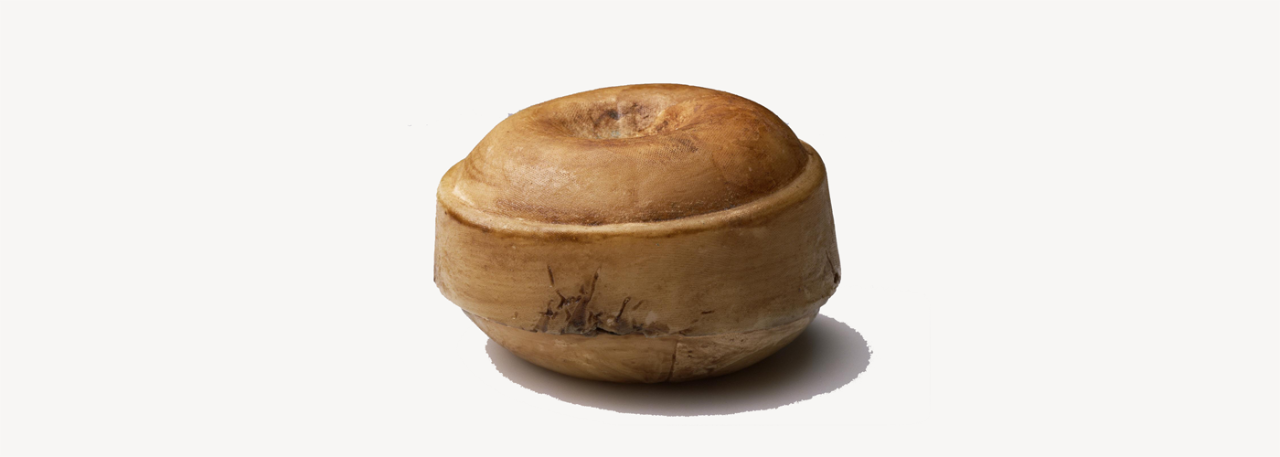.png.transform/rendition-xs/image_image%20(1).png)
Tronchón cheese
Traditionally-made cheese produced either with ewe's milk or with a mixture of ewe and goat's milk.
Tasting notes
The paste is compact and consistent, somewhat springy and with a hard texture. It has an assertive, intense and buttery taste, with a flavor of goat or ewe's milk and of the aromatic herbs on which the cattle feed. Strong taste, oily, slightly sharp and with an aroma of wild plants.
Other notes
This is an aged cheese which may range from soft-paste to hard. One of the most distinctive characteristics of this cheese is its cylindrical or trunk-like shape, with one of the two sides cleft like the crater of a volcano. The weight of this cheese varies from half a kilo to 2 kilos.
This type of cheese takes its name from the town of Tronchón (Teruel, Aragon) in the region of El Maestrazgo, the location today of one of the few cheese-makers (Queseros Artesanos de Tronchón) producing these cheeses.
The paste is whitish in color, without holes and not very elastic, whereas the rind is smooth and has an intense yellow color.
Cheeses from Tronchón are cylindrical in shape, with one or both sides cleft in the form of a volcano. If only one side is cleft, the other has a convex curve. The rind is usually engraved with floral or symbolic motifs or letters.
Production / Processing method
It is made with ewe or goat's milk. After collecting the milk in tanks, the cheese is made without mixing the different types of milk. The milk is taken from refrigerated tanks to a stainless steel curd tank, consisting of a rectangular recipient with two walls or chambers of hot water.
The temperature is raised to 30ºC and rennet is added to the mixture, which is then stirred for at least half an hour. To test the consistency of the curd, a broad-bladed knife is inserted into the cheese and turned to extract a piece of curd; if the walls cave in, this means that the cheese has not yet solidified, and if they do not, the mixture is ready to make the cheese.
A series of cuts are made in the cheese in all directions with the knife until it is in small pieces. It is then reheated to a maximum of 35°C while the curd is continually stirred with the paddles and the temperature rises. This allows the rice-sized grains (the form the curd now has) to shrink and release the maximum amount of whey.
When the tank reaches a temperature of between 32 and 35ºC the stirring is stopped and the cheese is allowed to stand for a time. A perforated tray is placed on the top of the tank, and the whey is removed into the curd cheese tank. Once it is it well drained, two more trays are placed on top to press the curd and release all the whey. It is left to stand for 25 minutes.
The mixture is divided into molds with the specific shape of the cheese and left to age for a minimum of 90 days in the case of hard cheese.
Geography / Relief and climate
Tronchón cheese is made in the Alto Maestrazgo region in the heart of the Sistema Ibérico mountains, in the provinces of Teruel (south of Aragon), Castellón (Valencian Community) and Tarragona (Catalonia). This is a high, wild area with a predominance of limestone rocks which form high ridges rising between a river system which has carved out deep gorges over the years.
The climate in the Maestrazgo is mid-mountain Mediterranean, with strong temperature contrasts and an annual average of between 12ºC and 8ºC. Rainfall is scarce, although more frequent on the eastern face of the mountain massif, decreasing towards the north and west.
Cheeses from Tronchón are cylindrical in shape, with one or both sides cleft in the form of a volcano.

